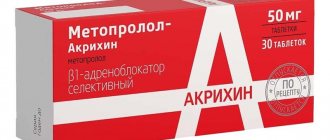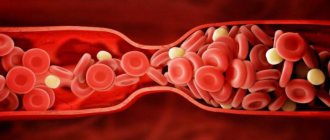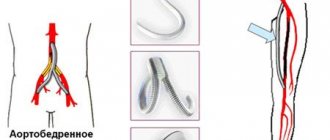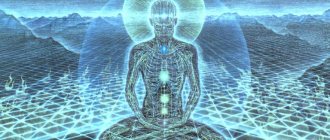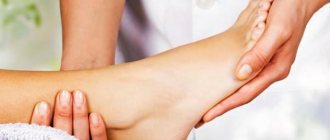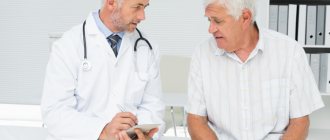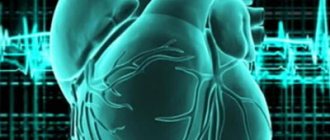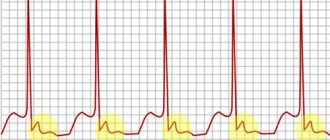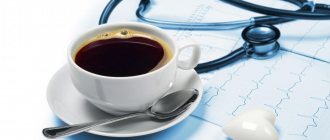Deviations from the norm in the frequency of contractions of a muscular organ are represented by a significant group of pathological processes. Some are more dangerous, while others, up to a certain point, do not pose a threat to the life and health of the patient.
Identifying the nature and origin of the disorder plays a major role in early treatment, without which there is no good prognosis for survival and continued ability to work.
Heart rhythm disturbance is a generalized name for a group of deviations from the norm. They are represented by changes in the heart rate itself (tachycardia - acceleration, bradycardia - deceleration), intervals between each subsequent beat (extrasystole, fibrillation, paroxysms, and sometimes atrioventricular blockade).
Treatment of arrhythmias is aimed at eliminating the root cause of the condition, as well as relieving symptoms. All measures are taken simultaneously.
Classification
Types of cardiac dysfunction are:
- Sinus tachycardia. Excessive stimulation of the natural pacemaker, increase in heart rate from 100 beats per minute.
- Paroxysmal form. Increase in heart rate to 250 or more.
- Atrial fibrillation, ventricular fibrillation. The development of abnormal electrical activity in the chambers of the organ.
- Extrasystole. The appearance of unnecessary contractions between beats, when there should be moments of rest. Single, this is a variant of the norm, paired, group - pose a danger to life.
- Blockade of the atrioventricular node, bundle branches. In a word - the conduction system of the heart. It ends in death if left untreated.
The classification is used by doctors to prescribe competent therapy.
Manifestations of sinus tachycardia
Specific features depend on the form of the deviation. Heart rhythm disturbances such as sinus tachycardia give the following symptoms:
- Increasing the frequency of contractions to 100 beats or more. Subjectively, it is felt as an acceleration of the activity of a muscular organ, a beating in the chest. With a long course of pathology, chronicity, the patient stops feeling anything and lives normally. At the same time, instrumental methods, including ECG, record the process.
- Dyspnea. After physical activity, sometimes even at rest, it depends on the human body and fitness level. Against the background of partially impaired gas exchange. This is the result of a decrease in the contractility of the heart and insufficient oxygen saturation of the blood. The symptom usually does not reach significant severity and is limited to minimal discomfort.
- Mild pain in the chest. Feeling of pressure. Lasts several seconds, sometimes minutes. Occurs sporadically.
- Increased sweating. Hyperhidrosis.
Usually this is all there is to it. Sinus tachycardia is the result of intensification of the natural pacemaker, a special accumulation of cardiomyocytes (cells) in the atrium. Therefore, such a process is less dangerous.
The abbreviations are correct. Although the frequency is broken. Exercise intolerance and suffocation are much less common.
Diagnostics
Before making a diagnosis, the cardiologist must conduct an initial examination, including diagnosing the pulse, heart rhythm by listening through a phonendoscope and ECG and collecting anamnesis data (information from the patient).
With atrial fibrillation, patients usually complain of irregular heart rate and increased heart rate.
The main method for diagnosing atrial fibrillation is an electrocardiogram and Holter monitoring, during which the patient’s ECG indicators are recorded throughout the day while the patient leads his usual lifestyle. To carry out monitoring, a special device is attached to the patient’s belt to record changes in heart rhythm.
Typically, it takes two days to a week to collect the necessary data, during which the patient experiences at least one arrhythmia attack. Based on this study, the doctor receives the following data:
- the type of atrial fibrillation and provoking factors are determined;
- pauses and deviations in heart rate at rest are detected;
- The duration of the attack, its nature and the area of the pathological focus are detected - in the ventricles or atrium.
Symptoms of bradycardia (decreased heart rate)
Rhythm disturbances such as bradycardia make themselves known by other signs:
- Reducing heart rate to 60 beats per minute or less. Usually not directly felt by the patient. A person pays attention to other manifestations.
- Weakness, drowsiness, asthenia. Due to the low contractility of the heart and insufficient blood circulation in the brain, asthenic signs occur. Nervous system disorders.
- Exercise intolerance.
- Paleness of the skin and mucous membranes (clearly visible in the gums).
- Cyanosis or blue discoloration of the nasolabial triangle. The calling card of all cardiac pathologies.
Bradycardia does not always have pathogenic features. During sleep, in trained people (athletes), after hypothermia, a slowdown in heart rate is characterized by a natural origin and is considered normal.
In severe cases, heart rate disturbances of this kind are accompanied by headache, vertigo (inability to navigate in space), and fainting. This is a negative sign, it indicates an acute malnutrition of the brain.
May be part of the so-called Morgagni-Adams-Stokes syndrome (a sharp drop in blood pressure, heart rate and supply of nerve tissue).
Drugs for atrial fibrillation (atrial fibrillation)
Properly selected therapy for atrial fibrillation (atrial fibrillation) allows you to:
- Prevent the formation of blood clots, which reduces the chances of developing a stroke.
- Slow the heart rate, allowing enough time for the chambers of the heart to fill with blood before pushing it further through the circulatory system.
- Control your heart rhythm, which allows the atria and ventricles to work together to better pump blood throughout the body.
To control heart rate, drugs from various pharmacological groups are used.
Beta blockers
- Nadolol
- Atenolol (Tenormin)
- Bisoprolol (Zebeta, Ziac)
- Carvedilol (Coreg)
- Metoprolol (Lopressor, Toprol)
- Propranolol (Inderal, Innopran)
- Timolol (Betimol, Istalol))
Calcium channel blockers. Used to slow the heart rate in patients with atrial fibrillation and to reduce the force of contraction of heart cells.
- Diltiazem (Cardizem, Dilakor)
- Verapamil (Calan, Calan SR, Covera-HS, Isoptin SR, Verelan)
Digoxin . This medicine slows the rate at which electrical currents are conducted from the atria to the ventricles.
After restoring the heart rhythm, the patient is given medications that help normalize heart function during subsequent attacks of arrhythmia (the so-called chemical / pharmacological cardioversion). Significant side effects may occur with their use, so your doctor will likely want to monitor the treatment process closely.
Sodium channel blockers , which slow down the ability of cardiomyocytes to conduct electrical impulses.
- Flecainide (Tambocor)
- Propaphenone (Ritmol)
- Quinidine.
Potassium channel blockers help restore the heart's rhythm by slowing the electrical signals that cause atrial fibrillation. Most often used:
- Amiodarone (Cordarone, Nexteron or Pacerin)
- Sotalol (Beta Pase, Sorine, Sotylize)
- Dofetilide (Tikosyn)
Anticoagulants and antiplatelet agents help thin the blood, which is necessary to prevent thromboembolism. Tablet drugs are mainly used:
- Acetylsalicylic acid (Aspirin)
- Clopidogrel and its analogues (Plavix, Zilt, Trombonet, Lopirel, Enterocard)
- Indirect anticoagulants (Warfarin, Coumadin, Jantoven) and analogues (Pradaxa, Xarelto, Rivarokshaban)
- Apixaban (Elikis)
- Dabigatran (Pradaxa)
- Enoxaparin (Lovenox)
- Heparin
Anticoagulants can reduce your chances of having a stroke by 50% to 70%.
These medications increase the risk of bleeding, so they should be taken very carefully, especially during games, sports, or other activities that may cause injury or bleeding.
Precautions: Blood thinners may increase a person's susceptibility to bruising or bleeding. For example, if warfarin is prescribed, then the patient must visit his doctor every month for a blood test. This allows you to make sure that the drug is working and that the correct dose is selected. Additionally, you should remember:
- While anticoagulant treatment is ongoing, you should monitor for bleeding and bruising. You should watch for bleeding from the gums or nose, blood in the urine or in the stool. When bathing, you should use a soft washcloth, and when brushing your teeth, choose a soft toothbrush. Otherwise, bleeding may occur from lesions on the skin and gums. For shaving, it is better to use an electric razor.
- It is important to tell your dentist and medical specialists that you are taking anticoagulants. You can even wear a bracelet or badge that indicates that the person is taking such and such medicine.
- Do not start or stop using this medicine unless told to do so by your doctor. Also, many drugs cannot be used with oral blood thinners (for example, NSAIDs in combination with warfarin increase the risk of bleeding, a similar effect is observed when taking an anticoagulant and a cytochrome P450 inhibitor together). Vitamin K, barbiturates, rifampicin, carbamazepine, etc. weaken the effect of the same warfarin.
- You should immediately tell your doctor if you missed a medication dose or if you exceeded the prescribed dose.
Warfarin is one of the commonly taken anticoagulants that may be needed during the treatment of atrial flutter or atrial fibrillation. The following are recommendations to keep in mind if you must take warfarin.
- Foods and medications can affect the amount of warfarin in your blood. You do not need to make major changes to your diet while you are taking warfarin.
- The drug works best when you eat about the same amount of vitamin K each day as before or even more. Vitamin K is found in green leafy vegetables and some other foods. It is worth asking for more information about what to eat when being treated with warfarin.
- You will need to see your doctor regularly while on warfarin therapy. In particular, regular blood tests will be needed. These tests are used to determine the exact dose of medication.
Atrial or ventricular fibrillation
It manifests itself in approximately the same way; the conditions can be distinguished only by the results of electrocardiography:
- Intense heartbeat. An increase in heart rate to 120-180 beats per minute, but in fact, during instrumental diagnostics, it turns out that there are not 180, but 250 or more. These are chaotic movements, they are not completely felt.
- Freezing in the chest, missing blows, turning over, tying in a knot, stopping. Such complaints are typical features of fibrillation.
- Impaired consciousness, fainting, headache, inability to navigate in space.
- Pale skin and cyanosis of the area around the mouth.
- Nausea, rarely vomiting, which does not bring relief.
- Weakness, drowsiness, decreased performance and general asthenia.
- Violations of mental status, cognitive, mnestic activity, speed of thinking, memory impairment.
Ventricular fibrillation is much more dangerous than atrial dysfunction. But both forms are potentially lethal, fraught with organ failure.
The essence of the pathology is fundamentally different when compared with bradycardia or tachycardia. It is not the sinus node that is involved. On the contrary, the signal is generated in all cameras. They contract at their own rhythm. Such uncoordination and irregularity ends in cardiac arrest and death of the patient.
Folk remedies for atrial fibrillation.
Atrial fibrillation is the most common disturbance in the rhythm of the heart, accompanied by relatively frequent, varied chaotic contractions, as well as excitation of the atrium. In one minute there can be from 350 contractions to 650 or more.
Folk remedies for atrial fibrillation can protect the body from all sorts of bad effects with side effects during treatment. But first, get competent advice from a doctor. Such treatment will also be harmless with other modern medications prescribed. Atrial fibrillation does not occur independently, but occurs due to other various diseases. The consequences are very negative and not favorable. Here we will describe special super recipes for properly getting rid of it.
Traditional treatment for atrial fibrillation.
Yarrow.
This is a well-known favorite plant, which can be found in the pharmacy in dry form if necessary. In a liter jar, but not smaller, sprinkle yarrow exactly up to half the jar. Fill it with good vodka to the very top. Let's put it in a place that is deprived of light for one decade. Before breakfast in the morning, we take a spoon from the tea service. Before lunch approaches, we repeat the dose.
Kalina.
The composition of especially necessary substances will repel this disease. If you wish, pick berries after frost. If you don’t want to, you can find them at the pharmacy. Dry the berries in the amount of half a simple glass. It is important to pour boiling water over them and simmer for about 5 minutes. It is also important for them to cool on their own. Drink about half a glass in the afternoon and the same amount in the late afternoon.
Adonis.
Adonis also causes the right treatment. A decoction from it will pleasantly surprise you in helping with treatment. Exactly 4 gr. put in water, which should boil. We torment him for three quick minutes. Next, it will be important to cover the broth and wait, 20 minutes will be enough. We filter and the broth is ready. We treat three times a day. The spoon should be a tablespoon.
An important decision you will make is whether you use prophylaxis after recovery. Eating with the right diet, doing exercises, and living a healthy lifestyle is a big step in prevention. We exclude habits from which harm comes.
Conclusion: Distribute other natural remedies in the comments of this site, constantly consult with a trusted doctor, even if it is the most harmless natural remedy for the treatment of heart and arrhythmia, share this article on your own social network. Before any heart treatment, carefully study all contraindications.
REMEMBER!!! It is important to believe with all your heart in the power of treatment. I sincerely wish you good health!!!
Extrasystole
May be single. Then there are no symptoms at all, it is considered a variant of the norm and occurs in all people without exception. Or group, pair (bigeminy). Much more dangerous for life.
Among the symptoms of the latter:
- Feeling of sudden blows. Normally, the systoles occur in the correct order. Between the peaks on the ECG graph there is a straight isoline, which indicates moments of relaxation of the heart. As for extrasystole, extraordinary contractions are wedged between the peaks, the correct heart rhythm is disrupted. They feel like extra blows that occur at the wrong time.
- Dyspnea. Against a background of complete peace. It intensifies with physical activity. However, the intensity of the symptom is not great. And with a prolonged course of the disease, the patient completely stops paying attention to the deviation. Compensation of the condition is observed.
- Chest pain. Episodic, a few seconds, maximum minutes.
The problem with extrasystole is the mild severity of symptoms. An abnormal heart rhythm is potentially fatal, can lead to death from cardiac arrest at any time, but is not sufficiently felt.
Therefore, the patient does not have time to react, and diagnosis turns out to be a matter of luck.
Sedatives that help with heart arrhythmias
Sedative-spectrum medications are sedatives that help normalize the heart rhythm; when taken, the heart begins to approach normal levels. In addition, the prescription of such medications helps prevent heart disease, improve sleep and relieve nervous tension.
Signs of atrial fibrillation are well relieved with tinctures of Corvalol, Valoserdin, Persen, Valerian, Novo-Passit and many others. In addition to tinctures, tablets are used for various manifestations of cardiac arrhythmia, which contain natural ingredients.
With the help of a combined list of tinctures and tablets, which are based on natural ingredients, as well as barbiturates and bromides, many manifestations of atrial fibrillation are relieved.
Similar sedative blockers containing valerian and motherwort are used as infusions. It is necessary to drip 20-30 drops to eliminate signs of disease. For workers in the service sector, students and schoolchildren, it is necessary to take such blood-thinning medications during the examination period.
If your health worsens when using them, then you need to stop drinking them.
Let's look at sedative medications from natural remedies in more detail.
- Antares 120 tablets consist of an extract of pepper rhizomes of an intoxicating variety. You can treat cardiac arrhythmia by taking 1-2 pieces of the drug daily for a 10-day period.
- Altalex. The concentrated essence is added to the tea drink in a dose of 10-20 drops. It contains a variety of natural ingredients, including mint, eucalyptus, lavender, fennel, thyme, cinnamon, sage, essential oils and lemon balm.
- Persen contains valerian extract, lemon and peppermint varieties. This medicine helps to get rid of arrhythmia, it is especially effective for older people.
- Novo-passit contains a wide variety of beta plants. Blocking properties are achieved thanks to components from elderberry, valerian, hawthorn, hops, St. John's wort, passionflower. Heart spasms are relieved after taking 1 teaspoon of the drug 3 times a day.
- The beta-blocking drug is Sanosan, which contains valerian and hops.
Sedative mixtures are taken for a variety of heart ailments, but they are taken 30 minutes before a meal, 50-75 ml.
The most popular are beta medications in the form of Corvalol, Valocordin and Valoserdin, which traditionally especially helps elderly patients. But it is worth using these medications strictly as prescribed by the attending physician.
If arrhythmia begins to bother you, then such a sedative medicine only helps relieve nervous tension and spasms, improve neural conduction; it is prescribed to normalize sleep, as well as in stressful situations.
Tinctures and tablets for cardiac arrhythmia have a moderate calming effect that helps inhibit the nervous system; they help reduce general excitability and nervousness.
Treatment with such tinctures takes place without causing damage to human health. They are used as preventive measures. They are able to eliminate arrhythmic manifestations, improve conductivity in the myocardium, and help ensure proper oxygen metabolism in tissue cells.
Such medications eliminate symptomatic phenomena, but not the cause of the disease. After taking them, the pain stops being felt, and a feeling is created that the attack in the thoracic region has stopped. But if such conditions are repeated very often, then sedative medications can no longer cure the disease.
Signs of AV block
As for atrioventricular block, its manifestations are always catastrophic.
- At grade 1, the symptoms are similar to those of mild bradycardia.
- On the second, there is a decrease in heart rate to 50 beats or less. Weakness, drowsiness, pallor, cyanosis, headache, vertigo, nausea, vomiting, excessive sweating are included.
- At the third stage, with a complete blockade, a stop occurs.
The essence of the pathology is a violation of signal conduction from the sinus node to the atria and ventricles.
Paroxysmal tachycardia
This is a form of fibrillation, it differs in a more pronounced component in terms of heart rate. The number of layoffs is growing to 300 or more, this is not the limit. The attack begins suddenly, with a strong shock in the chest.
The following are typical manifestations:
- Dyspnea.
- Dizziness, discomfort in the back of the head.
- Chest pain.
- Weakness, drowsiness.
- Increased sweating.
- Nausea, vomiting.
- Urinary retention, oliguria (decreased amount of urine).
- Loss of consciousness.
- Pallor, cyanosis.
- Instability of blood pressure. Mostly a decrease, which is temporarily replaced by an increase.
The paroxysm or attack lasts about a couple of hours. In advanced cases, a persistent continuous course is possible. But this is in the absence of quality treatment.
The episode always ends with polyuria - copious discharge of urine, which indicates the restoration of normal heart function. Read more about the paroxysmal form of tachycardia here.
How to delimit states on your own?
Examination and differentiation are carried out under the supervision of a cardiologist. It is possible to say anything concrete only after instrumental events.
The doctor suspects the disease long before the main activity of assessing the patient’s situation. Special “tags” help with this, which can indicate the nature of the violation.
- Sinus tachycardia differs from paroxysmal tachycardia in several ways. The heart rate during the first hardly reaches 200 beats per minute, this is a rare case. And against the backdrop of the second, 300 is not the limit. The attack begins sharply, suddenly, with a strong jolt in the chest. The sinus form starts sluggishly, the patient cannot even say when the disorder developed. In addition, paroxysm is accompanied by urinary retention.
- Classic tachycardias and bradycardias do not result in pronounced missed beats. The intervals between contractions are correct. There is no feeling of freezing, stopping or anything like that.
- Cerebral manifestations (headache, dizziness, loss of consciousness) are typical for dangerous forms of arrhythmia: fibrillation, extrasystole, heart block and paroxysm.
For the rest, you should trust instrumental methods.
Symptoms of cardiac arrhythmia
For a fairly long period of time, the pathology may not show itself, but most often the arrhythmia shows itself as negative symptoms that interfere with a normal life:
- Feeling of heart fluttering and rapid or too slow heartbeat.
- Attacks of dizziness and shortness of breath - they can strike the patient suddenly and also stop suddenly. The main symptom is their frequency.
- Pressing pain in the sternum, a feeling that the ground is disappearing from under your feet. This is due to a malfunction in the rhythm of the heart muscle and the provision of normal blood flow, which negatively affects the general condition and coordination of movements.
- Attacks of nausea and vomiting, as well as short-term blurred vision and loss of consciousness.
To make an accurate diagnosis, doctors, first of all, collect an anamnesis of the course of the disease and listen to the patient’s complaints, listen to the peripheral type of pulse.
To confirm or refute the preliminary diagnosis, doctors refer the patient for additional examination:
- ECG is a recording of the heart’s work and contractions, displayed graphically, allowing one to evaluate the rhythm itself and the condition of individual parts of the heart.
- Ultrasound and ECHO-cardiogram - using ultrasound, you can see the heart on the monitor, assess its condition, the functioning of the valves and diagnose scars after a previous heart attack.
- Daily Holter monitoring helps to diagnose arrhythmia during the patient’s usual daily routine. The patient himself keeps a diary of his general condition and symptoms.
- EPI is an accurate and fairly informative method for diagnosing pathologies affecting the heart muscle. The essence of the method is that a catheter with electrodes is inserted into the patient’s body, directly into the cardiac vein itself - then thermal radiofrequency influence is applied. This allows not only to diagnose the type of arrhythmia, but also to treat it.
We recommend reading: How to get rid of headaches at home
Instrumental diagnostic methods
It all starts with an oral questioning of the patient regarding complaints and collecting an anamnesis. Based on the signs presented, the specialist puts forward hypotheses. They are refuted or confirmed during further diagnostics.
- Measuring the heart rate allows you to determine the fact of a violation.
- Daily Holter monitoring is required to record the indicator over 24 hours, over time.
- Electrocardiography. Basic technique. It is relatively simple to distinguish between arrhythmias. But this requires sufficient qualifications of a cardiologist.
- Echocardiography. Ultrasound examination of the heart. Allows you to identify defects and anatomical defects that can cause rhythm disturbances.
- EFI. The same ECG, but invasive. Allows you to determine conduction deviations of cardiac structures.
- If necessary, MRI diagnostics are prescribed.
Depending on the suspected cause of the condition, consultations with other specialists (including an endocrinologist), assessment of the status of the central nervous system, the patient’s psyche, general blood tests, thyroid and pituitary hormones, biochemical, electroencephalography, and survey chest x-ray are possible.
The duration of the examination is about 5-7 days. In the hospital it’s even faster. But, as a rule, reasons for hospitalization of a person arise infrequently.
Signs and symptoms: what complaints do patients have?
The palette of clinical manifestations is varied and colorful: from normal health to loss of consciousness and arrhythmogenic shock.
Depending on the type of arrhythmia, psycho-emotional status and concomitant diseases, patients present the following complaints:
- heart sinking;
- heart beats against the chest;
- cardiopalmus;
- dizziness, darkening of the eyes;
- shortness of breath, feeling of lack of air;
- weakness, fatigue;
- loss of consciousness and so on.
These symptoms are accompanied by a feeling of fear and are not always specific. A similar picture of the disease is also described by somatically (physically) healthy people suffering from panic attacks, neuroses or phobias. In these situations, we are talking about psychosomatics, and work with a psychotherapist is required, and not treatment by a cardiologist.
Case study: arrhythmia in a woman
There was an interesting case in my practice: a middle-aged woman came in complaining of episodes of loss of consciousness. They occurred during physical activity (climbing stairs, riding a bicycle), which was accompanied by severe shortness of breath, and before falling, she felt a palpitation. Before contacting a cardiologist, the patient was examined by a neurologist, but no abnormalities were identified.
When conducting echocardiography of the heart, the following was visualized: secondary hypertrophic cardiomyopathy, which developed as a result of subvalvular aortic stenosis. Thickened left ventricular myocardium is a risk factor for the development of life-threatening tachycardias and sudden cardiac death. During 24-hour ECG monitoring, runs of ventricular arrhythmia of varying duration were recorded.
The patient was sent for surgical treatment - correction of the heart defect and ablation (cauterization) of the arrhythmia area.
Features in men
A special feature of arrhythmia in men is “holiday heart syndrome.” This is a condition in which, after short-term consumption of large doses of alcohol (usually during feasts), arrhythmia occurs. More often, atrial fibrillation (atrial fibrillation) or ventricular arrhythmias occur.
Clinically, this syndrome is manifested by a feeling of palpitations, a feeling of weakness, shortness of breath, and chest discomfort, which can lead to arrhythmogenic death. The mechanisms of alcohol’s effect on the heart include both direct toxic effects and increased activity of the sympathetic nervous system and electrolyte imbalance. In chronic alcoholism, cardiomyopathy develops, the main manifestations of which are heart failure and cardiac arrhythmias.
If you stop drinking alcohol in time, there is a chance to restore the pumping function of the heart, but scientists have not been able to find out where the limit is when it is not too late. The attitude towards drinking in our country is very frivolous; people believe that alcohol “cleanses blood vessels” and its consumption is associated with health benefits. Yes, systematically drinking people rarely have heart attacks - they die from sudden arrhythmias, before thrombosis occurs.
Causes
It is impossible to list all possible causes. Only the most common ones should be cited.
Slow heart rate
- Excessive training of the body (in athletes).
- Sleep, period of night rest.
- Hypothermia.
- A recent heart attack, cardiosclerosis (scarring of the heart muscle after necrosis, death).
- Pregnancy.
- Puberty, puberty.
- Brain tumors.
- Heart defects.
- Poor nutrition of cerebral structures.
- Lack of thyroid hormones (hypothyroidism), adrenal cortex (Addison's disease).
- Impaired cardiac conduction. Block of the bundle branches, atrioventricular node.
Heart rate acceleration
- Arterial hypertension, pressure instability.
- Anatomical defects of valves (tricusipdal, aortic, mitral).
- Atherosclerosis.
- Bulging of heart structures or blood vessels (aneurysm).
- Angina pectoris, current heart attack.
- Infectious diseases. Simple colds are possible.
- Increase in body temperature.
- Intoxication with toxic substances (metal salts, mercury vapor, cardiac glycosides and others, including psychotropic drugs and anti-inflammatory drugs).
- Hyperthyroidism (excess thyroid hormones), pheochromocytoma (tumor in the adrenal glands).
Irregular contractions
- Defects, congenital and acquired, are the main cause of heart rhythm disturbances.
- Blockade of the conduction system of the heart.
- Chest injuries.
- Tumors of various localizations.
- Poisoning.
- High body temperature.
- Bleeding, anemia.
- Diseases of the stomach, duodenum.
Diet for arrhythmia
Diet for diagnosed arrhythmia is an important component of successful treatment. So from the diet it is worth removing foods that will stimulate the central nervous system and heart muscle and do not contain salt.
We recommend reading: How to properly treat angina at home
It is worth introducing into your diet foods rich in calcium, potassium and magnesium - those elements that will help restore the heart.
The diet should be built according to the principle - 60% are vegetables and fruits, 30 - foods rich in carbohydrates and 10 - proteins. You can steam them or serve them boiled, bake, but frying them is a taboo for arrhythmia. You should eat according to the principle of fractional meals - we eat little and often, and all dishes should be warm, and the daily calorie content should not exceed 2,500 - 3,000 thousand calories.
It is also worth monitoring your own drinking regime. Juices and fruit drinks, juices and herbal teas, clean water - you should drink up to 1.5 liters per day, which improves metabolic processes in the body.
Treatment
Therapy is carried out under the supervision of a cardiologist. If there are third-party pathologies, other doctors are also involved. Three tasks need to be solved: eliminate the root cause, relieve symptoms and prevent complications.
Etiotropic effect. Aimed at stopping the main development factor. There are options here. Heartbeat disturbances do not always occur for cardiac reasons.
It is possible to use hormonal drugs, surgeries for resection of the thyroid gland, removal of brain tumors, adrenal glands, heart and vascular defects, and other defects.
In milder cases, medications are used. Which:
- Antihypertensive. Normalizes blood pressure. ACE inhibitors, centrally acting agents, calcium antagonists, diuretics.
- Beta blockers. They relieve attacks of tachycardia and normalize blood pressure levels.
- Antiarrhythmic. According to indications, short courses.
Symptomatic treatment consists of prescribing the same drugs, but in different dosages.
To eliminate foci of excessive activity against the background of paroxysmal tachycardia and restore heart rhythm, radiofrequency ablation is possible. Cauterization of areas of the heart in waves.
To stop an acute attack of rhythm disturbance, electrocardioversion is performed. Passing current through the myocardium. Despite the frightening description, there is nothing dangerous or scary in the procedure. The patient does not feel discomfort.
Attention:
Treatment with folk remedies is unacceptable. Most recipes are ineffective, while others, such as tinctures of elderberry, lily of the valley, and chokeberry, are too harsh. May lead to cardiac arrest.
It is important to change your lifestyle and adjust it in accordance with the recommendations. Sleep at least 7 hours a night, walk in the fresh air for at least an hour a day, avoid fatty foods and excess salt.
Do not overwork, avoid physical overload. No smoking, alcohol, or self-administration of medications.
Treatment of the disease
The effectiveness of therapy depends on high-quality diagnostics. Treatment of arrhythmia is determined by the pathology that was the root cause of the development of disorders. Depending on this, methods and treatment regimens are selected for each patient individually.
Traditionally, 2 methods of combating the disease are used:
- conservative therapy. Involves the use of various medications. In case of pathological changes in the heart, you should take medications aimed at strengthening the myocardium and restoring its functionality: beta blockers, diuretics, calcium channel blockers, statins. In case of increased nervous excitability, sedatives are prescribed: Persen, Afobazol, Novopassit. Drugs that have a direct effect on normalizing heart rate: Cordarone, Sotalex, Propafenone.
- surgical interventions are indicated in extreme cases in the presence of serious pathologies. Currently, surgery can be replaced by radiofrequency ablation. Radiofrequency waves cauterize a small area of the myocardium. The procedure stimulates the uninterrupted functioning of the scar and also helps restore the functionality of the tissues adjacent to the scar.
If there is a threat to life, surgery to implant a pacemaker is prescribed. The device is designed to maintain heart performance at a certain level and performs stimulation in case of cardiac arrest.
Forecast
Depends on the root cause. The possibility of radical elimination initially gives good chances of preserving not only life itself, but also its high quality.
The more difficult it is to cure the underlying process, the more difficult it is to deal with rhythm disturbances.
- Sinus tachycardia and single extrasystoles are not dangerous and can be easily eliminated, therefore the prognosis is favorable in all respects, complete recovery is more than likely.
- Paroxysms, fibrillation and other types are much more severe, the probability of death varies between 15-30% or more, depending on the stage. In this case, cardiac arrest can occur at any time.
- An acute disruption of the heart rhythm, an attack, leads to death much more often. The immediate prognosis is getting worse. Frequent repetitions of episodes also do not bode well for the patient.
It’s best to check your prospects with your doctor. A lot of factors are taken into account: from age, gender and medical history to the form of the disorder, duration, response to the use of drugs, and the possibility of radical therapy.
Reasons for development
Before you learn how to treat a pathology, you should consider its description and origin. The causes of heart rhythm disturbances may lie in other diseases. They are determined by the attending physician, for which a detailed diagnosis is carried out.
In accordance with the etiological factors and the mechanism of development of the disease, two forms of arrhythmia are distinguished - functional and organic. As for the latter, it is a frequent companion to myocarditis, ischemic heart disease, injuries, defects, insufficiency, VSD, complications after surgery.
If a heart rhythm disturbance occurs, the reasons for this may be:
- overwork;
- stressful situations, lack of sleep, proper rest;
- bad habits;
- poor nutrition, excess weight;
- brain injury, which negatively affects the human nervous system;
- pathologies in the spine;
- disruption of the functioning of various organs and systems;
- gynecological diseases;
- high blood pressure, cardiovascular diseases, ischemic heart disease, heart attack, stroke;
- the influence of toxins and harmful substances on the body;
- self-medication;
- pathologies of the thyroid gland, diabetes mellitus.
In order to provide first aid for arrhythmia in a timely manner, it is advisable to know what the symptoms of a heart rhythm disorder look like. It is interesting that changes in the electrolyte balance in this organ provoke the development of arrhythmia. The process significantly complicates the contractile capabilities of the muscle.
Complications
There are several consequences:
- Heart failure.
- Pulmonary edema.
- Heart attack. Acute necrosis as a result of insufficient blood circulation in the myocardium.
- Stroke. The death of cerebral structures, nervous tissues of the brain as a result of the same ischemia.
- Vascular dementia. Dementia, decreased efficiency of thinking, loss of memory, cognitive and mental abilities in general.
It appears when there is little nutrition to the brain. If it is possible to completely eliminate the cause, it disappears without any special consequences. The symptoms resemble Alzheimer's disease and require differential diagnosis with it.
In all cases, the result of emergency conditions (except for dementia) is death, or at least severe disability.
Atrial fibrillation
Regarding the treatment of the flickering type of arrhythmia, it is important to take into account its shape and correctly adjust the rhythm of the heart.
Relief of arrhythmia attacks in a patient is possible by prescribing the following drugs:
- Alapinin and Etatsizin.
- Taking into account the severity of the arrhythmia, Novocainamide is prescribed, and a drug such as Disopyramide should be taken with caution, since it is contraindicated in developing prostate adenoma and glaucoma.
- Bancor or Quinidine - in particular the latter has many contraindications and therefore is taken strictly under medical supervision.
To avoid the development of an acute form of pathology, a course of glycosides is prescribed, for example Korglykon, and if atrial flutter is diagnosed, Finoptin and Isoptin are administered intravenously.
We recommend reading: Atherosclerosis of cerebral vessels: causes and treatment at home
In case of development of a chronic form of pathology, a course of taking adrenergic blockers is prescribed. And for radical treatment of flickering arrhythmia, doctors are increasingly using radiofrequency isolation of the source of potentially dangerous excitation.
You can also learn about the symptoms and treatment features of arrhythmia from the following video:
